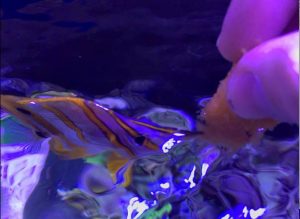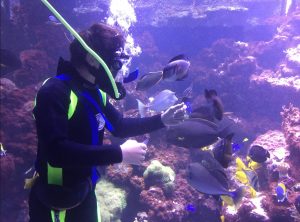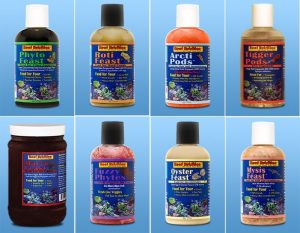
Photo courtesy of reefaquarium.com
Not long ago, I explained on Facebook that it takes me about 45 minutes to feed my reef tank. Multiply that by three feedings per day, and over two-hours daily is spent on feeding alone. Reef keepers had a lot of questions, as to why I would spend so much time feeding. Some boasted that they use automatic feeders, and don’t have any time invested in feeding their tank. Others were confused about why a single feeding could take 45 minutes. I did my best to explain why feeding my reef took so long. I reminded aquarists of the importance of feedings, and the role they play in daily tank observation and management.

Photo courtesy of LRS foods. These fish are being fed LRS’ Reef Frenzy blend, presented on a common magnetic algae clip.
The reality is that feeding is both complex, and vitally important. Nutrition can help maintain strong immune systems in our fish, while also providing the amino-acids needed for cellular growth along with vital compounds that increase the intensity of color pigments. Improper nutrition can lead to diminished coloration, a thin appearance and even a weakened immune system. While many aquarists feed their fish high quality foods, it’s equally as important to pay attention to how, along with what, you’re feeding. Various fish accept food in different ways, and very few species will accept the exact same thing, under the exact same presentation. Often food is tossed into the tank, and allowed to trickle down through the water column, until it reaches the bottom. Feeding only in this way, is like preparing a thick steak for a family dinner, and asking your relatives to eat it off the floor. No matter how enticing a food item is, without the proper presentation, it’s likely to be ignored.
Environmental triggers and feeding:

Photo courtesy of Larry Dupont, Larry’s Reef Services LLC.
When I worked at Pittsburgh’s PBG Zoo and Aquarium, aquarists were having a difficult time properly feeding the large (100,000 gallon) ocean exhibit. The tank was filled with several shark species, moray eels, large grouper and a menagerie of angelfish, tangs, wrasses and more. The smaller fish seemed to dart up to the food quickly, but the sharks and larger fish ignored it. After studying the tank at feeding time, it was decided that each group of fish, needed a chance to feed on their specific fare. For example, the sharks needed a chance to eat, specifically consuming what they accepted. After that, mid-water feeders could have a chance to enjoy their fare, and finally bottom dwelling species like the eels, would get their food.
To make this work, environmental triggers were put into place, consistently used until various fish species knew when it was their turn to eat. It started with the sharks, and long rods with colorful shapes attached to them, were placed into the water, signaling to the sharks that it was time to eat. While it took the sharks some time to get used to these triggers, they eventually did, responding aggressively as soon as the shapes broke the water’s surface. To signal the mid-water feeders, several of the tank’s circulation pumps were de-activated, lowering the flow-rate within the tank.
Finally, for the bottom dwelling species, all the circulation pumps were deactivated. In the absence of flow, food dropped steadily to the bottom, and moray eels and other fish at the bottom, knew it was time for a meal. It’s a simple technique, using environmental triggers to communicate to your fish that it’s chow time. However, it takes time.
Most of us keep more than one species of fish. In fact, several different species may have similar feeding routines, but it’s unlikely all the fish in the tank have the same feeding behavior. Nor is it likely that every fish will accept the exact same type of food. Even in the home aquarium, using environmental triggers to feed all the tank’s species, is a viable way to maximize each feeding’s efficiency. By far, the easiest environmental trigger (and safest as well) is flow manipulation.
Ensuring fish get their meal, step by step:

Photo courtesy of Larry Dupont, Larry’s Reef Services LLC. Hayden DuPont feeds a school of fish, in the 20k gallon + aquarium of Bill Wann.
One major first step to feeding, is simply washing your hands. I recommend basic Dawn dishwashing soap, as it removes oils and grime. Don’t go for something that is anti-bacterial. Any bacteria on your hands is unlikely to survive in the marine environment, and anti-bacterial soaps could unintentionally do more harm than good. After that, it’s important to turn off your skimmer, carbon reactor, UV or ozone generator (which will kill live coral foods, such as phytoplankton) along with deactivating your circulation pump(s) and main system pump.
Not only does this stop all flow and let the fish know it’s time to eat, it also prevents food from heading out the overflow and into a filter sock. I start with a mixed blend food (I prefer LRS’ Reef or Fertility Frenzy), which has a little something for everyone. Once thawed, I sprinkle the food slowly over the surface area of the tank. It’s important to do this slowly, moving your fingers just enough to break-up the food. Otherwise, you may frighten the fish and ruin the entire feeding. I give the fish a few minutes to pick through it, until most of the suspended food particles are gone (either eaten or resting on the bottom). Now I activate one circulation pump, (but not the main system pump) which starts churning some of the sunken food, bringing it back into the water column.
Since I have several wrasse species in my tank, along with a true Japanese swallowtail angelfish, there is a viable reason to feed something for small mouthed, mid-water planktivores. The reality is, mid-water planktivores are often unlikely to take large pieces of food, even chunks of mysis shrimp. To cater to these species, after the first round of feeding is over, I aim a mixture of brine shrimp and fish eggs right over the running circulation pump. This distributes it evenly throughout the water column, allowing the fish to pluck it from the current, as they would in the wild. Again, I allow these species a few minutes to eat, until the food is pulled from the water column.
Then, I activate the second circulation pump, which begins stirring up both large and small chunks of food. This normally triggers a final, aggressive feeding response from all the tank’s inhabitants.
Ensuring your corals get a go:

Photo courtesy of National Oceanic Atmospheric Administration (NOAA).
Many aquarium corals do just fine with only the excess nutrients produced by zooxanthellae during photosynthesis. Though, during a University of Hawaii study, it was found that corals receiving supplemental feedings in the aquarium, often had better growth rates and stronger coloration over those that didn’t. Reef Chili (Bulk Reef Supplies’ in-house blend) and Reed-Roids (Polyp Lab’s blend) are the two coral foods that fared best, and produced the most measurable results. Both are freeze-dried planktonic blends, that don’t require refrigeration, but do require being mixed with tank water. These types of foods are best suited to target feeding, and I have personally found that Two Little Fishies’ Julian’s Thing is the weapon of choice, for effective, waste-less target feeding.
The first part of coral feeding, is target feeding, which I personally recommend doing one to two times per week. Excess target feeding doesn’t produce heightened results, and more than likely will agitate your corals and degrade water quality. Target feeding, IMHO, works best when supplemented with a liquid coral food, which can be dispersed daily in the water column. I’ve found the ideal time to target feed (and dispersion feed) corals, is after fish have eaten, not long before the tank’s lights shut off. Since you’re running circulation pump(s), before starting to target feed, you’ll need to turn them off. You want the tank to be entirely still.
Target feeding is tricky for newbies. Mixing coral food is easy, as you just add a cup or so of aquarium water, the food and mix. It’s getting the rate of dispersion down, that takes some time. LPS corals often respond best, when coral food is very slowly released from whatever apparatus you’re using. Too fast, and the food just falls off the coral, too slow and it builds up causing mucus and stress. Food should be added to corals with visible tentacles, and dispersed over coral’s visible mouths. You’re looking for a response, sometimes a slight closing up and sometimes curling flesh inward and releasing tentacles. It doesn’t take much food per coral, and once you notice a response from the coral, you’ve likely dispersed enough food.
Moving from coral to coral, a target feeding is completed when all LPS and soft corals have gotten some food, and shown a response. For SPS species, with polyps too small to accept a mixed planktonic blend, I recommend dispersion feeding of phytoplankton or Oyster Feast by Reef Nutrition. However, before adding these blends, I recommend leaving the circulation pumps off for 15 minutes or more, allowing the corals ample time to accept food.
Once this is complete, you can boot up all your circulation pumps, along with your system’s main pump. You will notice some free floating food, stirred up off the tank’s bottom, along with some plankton laden mucus, shed off by your corals during feeding. It’s at this point a dispersion blend can be added. Mechanical filtration will remove most foods, once they drain down the overflow, however liquid phytoplankton is difficult for even a filter sock to remove. It’s vital now, to leave your skimmer, filtration, etc off for several hours, which also makes feeding time a great time to dose.
Feeding time is for more than food:

Photo courtesy of Larry Dupont, Larry’s Reef Services LLC. Once fish become accustom to a feeding schedule, and food presentation, they often are eager to accept food.
Many aquarists have automated their feeding routine, or wrap it up in under 10 minutes. They literally throw a food blend into the water, or stick frozen food to the glass and essentially walk away. Feeding time is often when problems with livestock can first be diagnosed. It’s an opportunity to visually inspect the health and vitality of your animals. Fish that often have a strong feeding response, then suddenly do not, are often teetering on the verge of illness, or extreme stress. During feeding, you have a chance to interact directly with your aquarium. It’s a valuable time, that is also redundant in that it can be used to consistently (and daily) measure the condition of your tank.
Variety is the spice of life:
Frozen food blends are a valuable tool for feeding marine fish, and most have a few things thrown in for the tank’s un-seen inhabitants, including clean-up crews. However, marine fish need a varied diet, both for nutritional purposes and to be enticed to eat regularly. For example, I feed a mixture of 8-10 different foods to my aquarium system. It’s my belief that many marine aquarium fish are underfed, largely because aquarists are trying not to raise their water’s nutrient value. This lack of adequate nutrition, could be a catalyst for everything from short lifespans to consistent parasitic and bacterial infections. In addition to a varied diet of food-stuffs, marine animals need food fortified with amino-acids and vitamins. Probiotics are becoming popular these days, and LRS Foods adds probiotics to all their frozen blends. Lab tests show that probiotic infused foods offer promising results, when fed on a consistent basis.

Photo courtesy of Larry Dupont, Larry’s Reef Services LLC. A good fish blend incorporates a host of different marine fare, into one easy to feed blend.
It’s also important that you cater to specific species dietary needs. For example, any herbivorous fish (such as a tang or angelfish) should have seaweed available 24/7.
Filtration, filtration, filtration:
The more food you add, the more your fish produce waste, the more nutrients that end up in your water. This is a simple fact. Years ago, it wasn’t uncommon for reef-keepers to profess a methodology that suggested only allowing fish to eat natural fare, found while scavenging the tank. Today, there is a host of filtration technology that allows for complete feeding regimes, and also maintains reef-level water. Protein skimmers are more powerful than ever, and aquarists should select one oversized for their tank. I often recommend doubling up on skimmer size. If you’re total system’s water volume is 100 gallons, select a skimmer rated for 200 gallons.

Photo courtesy of Korallin Zucht. Korallin’s sulfur de-nitrator is a well established system that can produce nearly undetectable levels of nitrate, even in a heavily fed tank.
One of the reasons I am an advocate for sulfur based nitrate reactors, is that they allow for heavy feeding, yet still maintain a nearly un-detectable nitrate level. These units aren’t difficult to use, and there are more on the market now, than there has been in the past. Unlike bio-pellets and other nitrate removal medias, sulfur based nitrate reactors never require a media change, or the addition of a carbon source. You can literally set them up, and forget about them.
Ozone is a worthwhile expenditure for heavy feeders. Many liquid coral foods, along with some fish foods (especially those with beta-carotene) have tannins within them, that can discolor tank water. Ozone breaks those tannins down, leaving water crystal clear.

Photo courtesy of Reef Nutrition. Reef Nutrition specializes in high quality coral and fish foods.
My recommended fish food list is below. They are listed in the order to be fed, with 5 minute breaks in between each, to allow the animals time to consume the food.
- LRS Reef Frenzy/LRS Nano Frenzy mix
- Reef Nutrition Beta Brine/LRS Fish Eggs mix (rotate beta brine between Artic Pods and Mysis Feast)
- Target feeding with Reef-Roids (2x per week)
- Dispersion feeding of Phyto Feast Live and Oyster Feast










Excellent article! I totally agree with you. I’ve wanted to feed like this which is why I purchased the Korallin Bio-Denitrator 1504 model. What feed pump do you use or recommend? I’ve been using a TOMS Aqualifter Pump that was suggested to me, but often the drip rate slows down on me without me adjusting. I have been running it for 9 months now; I start out following their vague instructions (start 1 drip per sec, measure, then increase drip rate, etc..). In my small 75gal system which only has 4 fish, I’ve been able to lower nitrates from 20-30 to 10ppm, and this is without heavy feeding (I was waiting to reach zero n03 before starting that). After my drip rate reaches about 3 drips per second, a day or two with that drip rate and nitrate starts to climb up. Obviously I’m doing something wrong or the feed pump I’m using maybe has something to do with it. If you wouldn’t mind giving me any advice you may have, maybe explain to me your method on how you started yours up/got it to lower all your nitrates? I’d be so grateful; I’ve tried several tweaks, researched, sought advice to no avail which is getting frustrating and hopeless. If you’d prefer, you can email me at [email protected]. Thank you Jeremy for any help you may be able to provide! – Dustin Getta
Dustin. I sent you an email.
Hi Jeremy,
Such a great article as I want to apply your suggestions to my tank feeding schedule. I’m curious to why you were using LRS Fertility mix and not LRS Fish Frenzy when mixing with the reef frenzy.
Thanks!